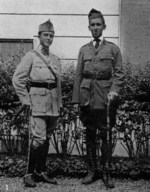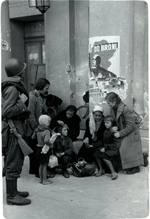Julien Bryan
| Surname | Bryan |
| Given Name | Julien |
| Born | 23 May 1899 |
| Died | 20 Oct 1974 |
| Country | United States |
| Category | Photography |
| Gender | Male |
Contributor: C. Peter Chen
ww2dbaseJulien Hequembourg Bryan was born in Titusville, Pennsylvania, United States in 1899. In 1916, he volunteered with the American Field Service for the French Army, driving an ambulance in Verdun and the Argonne. Upon his return, he wrote the book Ambulance 464 about his experiences in WW1; the book was illustrated with photographs that he had taken. In 1921, he graduated from Princeton University in New Jersey, United States. He then moved on to complete studies at the Union Theological Seminary, although he chose not to be ordained as a minister. He then spent some time as the director of a YMCA center in Brooklyn, New York, United States. Beginning in the late 1920s, he began traveling with great frequency, writing travelogues and taking photographs; among the countries he had visited included China, Georgia, Russia, Poland, Germany, Switzerland, and the Netherlands. His trip to Germany in 1937 resulted in a rich visual archive of daily life under the Nazi regime, both for non-Jews and Jews. When the European War began with the German invasion of Poland in Sep 1939, he found himself to be in Poland by chance. He arrived in Warsaw, Poland on 7 Sep 1939 and was able to secure an automobile from Mayor Stefan Starzynski. With the aid of interpreter Stefan Radlinski, he took hundreds of photographs and used 5,000 feet of motion picture film, documenting the German air attacks on the city. He recalled an incident at a potato field; one of the photographs he had taken at this field would become an iconic image of the campaign for Poland.
ww2dbaseAs Bryan exited Eruope via the German city of Königsberg, he hid his film within various objects to avoid confiscation. Returning to the United States, a number of his photographs from Warsaw were published. 15 were seen in the 23 Oct 1939 issue of Life magazine, and 26 were seen in the 5 Dec 1939 issue of Look Magazine. In 1940, he produced a short documentary, "Siege", on the attacks on Warsaw, released by RKO Radio Pictures; he would later write a book by the same title. During the war, he would be employed by the Coordinator of Inter-American Affairs and the State Department to make educational films. After WW2, he founded the International Film Foundation in 1945, which was devoted to the creation of documentary films for the school market. He returned to Poland in 1946 and again in 1958. During the 1958 trip, he published hundreds of his 1939 photographs, and through this effort he met with some of the people he had filmed almost 20 years prior. In Aug 1974, he was awarded the Merit for Polish Culture medal by the Polish government. He passed away in Oct 1974. In 2003, his son Sam Bryan donated his war time photographs and motion pictures to the United States Holocaust Memorial Museum.
ww2dbaseSource: Wikipedia
Last Major Revision: Nov 2018
Julien Bryan Mapa Interativo
Photographs
 |  |  |  |
Photographs Taken by Julien Bryan
 |  |  |  |
Julien Bryan Timeline
| 23 mai 1899 | Julien Bryan was born in Titusville, Pennsylvania, United States. |
| 7 set 1939 | Julien Bryan arrived in Warsaw, Poland. |
| 21 set 1939 | Julien Bryan departed Warsaw, Poland. |
| 23 out 1939 | Life Magazine published 15 of war time photographs of Warsaw, Poland taken by Julien Bryan. |
| 5 dez 1939 | Look Magazine published 26 of war time photographs of Warsaw, Poland taken by Julien Bryan. |
| 20 out 1974 | Julien Bryan passed away in the United States. |
Você gostou deste artigo ou achou este artigo útil? Se sim, considere nos apoiar no Patreon. Qualquer valor já vai ajudar! Obrigado. Por favor, ajude-nos a divulgar o site: Fique atualizado com WW2DB: |

» Invasion of Poland
- » 1,182 biografias
- » 337 eventos
- » 45,119 entradas na linha do tempo
- » 1,249 navios
- » 350 modelos de aeronaves
- » 207 modelos de veículos
- » 376 modelos de armas
- » 123 documentos históricos
- » 261 instalações
- » 470 resenhas de livros
- » 28,415 fotos
- » 365 mapas
George Patton, 31 May 1944
Por favor, considere nos apoiar no Patreon. Mesmo R$1 por mês já faz uma grande diferença. Obrigado!
Ou, por favor, nos apoie adquirindo alguns produtos do WW2DB na TeeSpring. Obrigado!